Where was Brownsville Landing?
My next crowd-sourced search is for the exact location on the Hatchie River of Brownsville Landing.
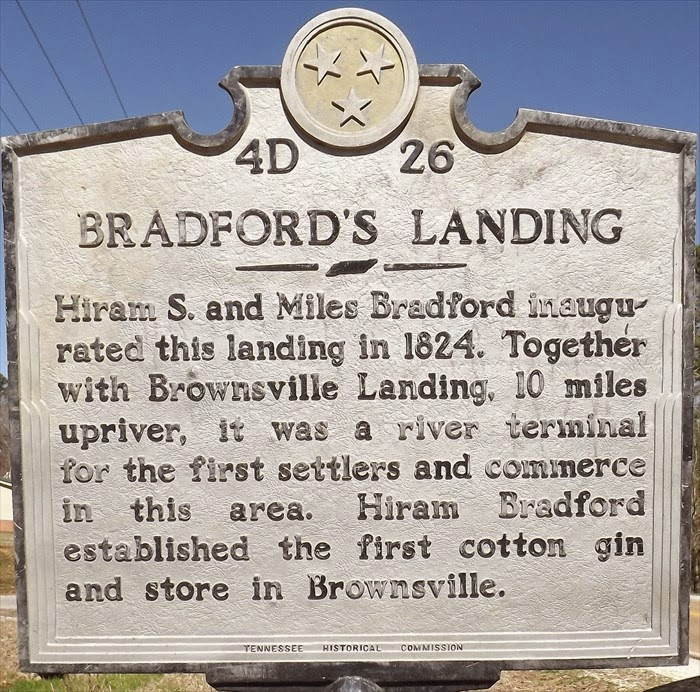
The only real clue I can find so far is on a historic marker for Bradford’s Landing that can be found at the intersection of U.S. 70 and River Bend Road. It includes the fact that Brownsville Landing was “10 miles upriver from Bradford’s Landing.”

Based on that, it seems Brownsville Landing was likely close to Sugar Creek since that would have enabled them to get things from the town of Brownsville to the Hatchie on a flatboat.
However, today there seems to be no physical indications that anything has been there other than the river and a lot of trees. Send me a message on Facebook or post down below if you have any additional information about where Brownsville Landing was was located.
Now, here’s a bit more about the Hatchie River I discovered while looking for Brownsville Landing.
For me, the Hatchie was just a small, muddy river I occasionally noticed on my way from Memphis to my grandparent’s house, but for those early settlers it meant survival. I’ve also since discovered the Hatchie is notable because it’s the longest naturally meandering river left in the Lower Mississippi Valley and is the only major river in West Tennessee that’s never really been changed. The Hatchie River still looks today very much like it did when our ancestors first arrived.
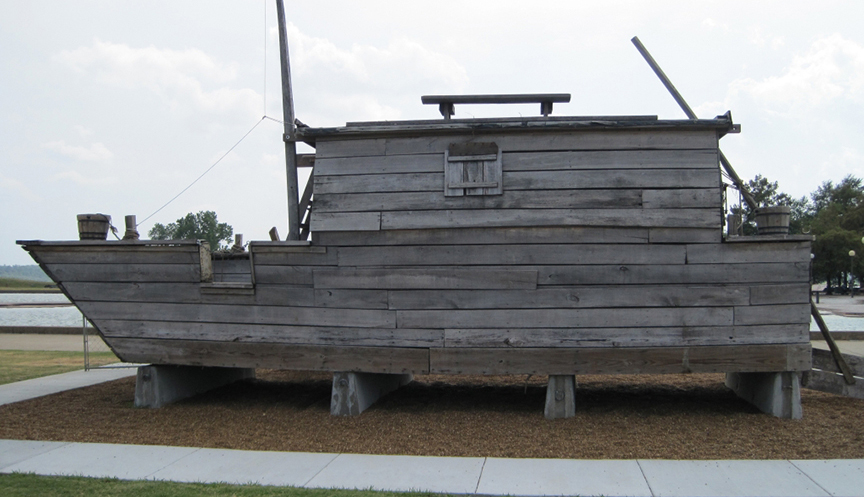 Photo: By Thomas R Machnitzki via Wikimedia Commons
Photo: By Thomas R Machnitzki via Wikimedia Commons
Modern replica of an early 1800s flatboat
Gone and Almost Forgotten
Early West Tennessee settlers like Hiram S. Bradford, Richard Nixon and Daniel Cherry capitalized on the river traffic by creating landings where rafts, flatboats and steamboats stopped to rest, procure supplies through purchase or trade or to load cotton and other crops to get them to Memphis. Like the schools and churches, they also provided an opportunity for social connection in a time and place where many in the community were isolated.
However, these landings weren’t needed long. The incredible quality of the fertile soil was the reason people were willing to leave friends and family and make a difficult and sometimes deadly trek to settle in Haywood County in the first place. After those early years of clearing trees and planting cotton, corn and other crops, they quickly turned their attention to transportation. Roads and trains made it easier and quicker to get all those crops to Memphis and other large cities. The water that made the soil so desirable in the first place was suddenly in the way, so streams were damned, levees were built and bottomland hardwood forests were cleared and then drained.
Unlike the Hatchie itself, the surrounding tributaries and waterways bear no resemblance today to what they were like in the past. While I haven’t found much, there are a few places where you can get a little peak behind the curtain of history to get a sense of how the water actually impacted our ancestor’s lives.
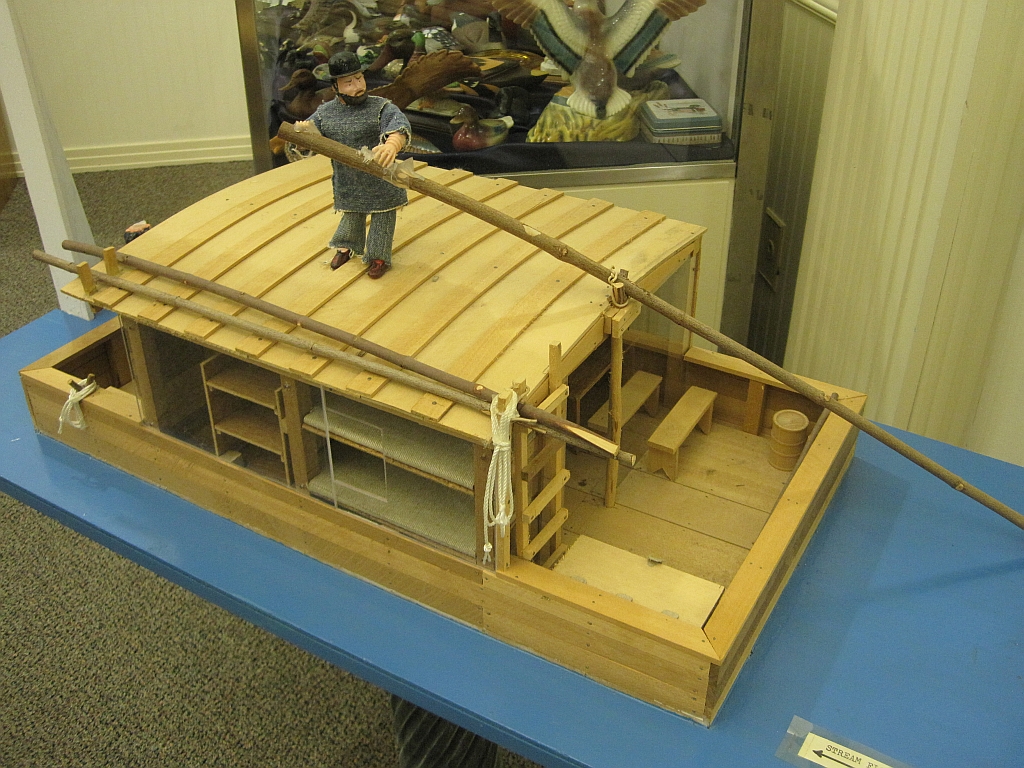 Photo: Thomas R Machnitzki via Wikimedia Commons
Photo: Thomas R Machnitzki via Wikimedia Commons
Model of a Hatchie River flatboat at the West Tennessee Delta Heritage Center
Passing Off Time at Brownsville Landing
Samuel Edmund Taylor (1828-1905) was from one of Haywood County’s first families and was one of the rare early Haywood Countians who kept a diary. He was a grandson of the Reverend Howell Lewis Taylor (1754-1845) who brought his family—which included five sons—from Virginia to Tennessee in 1826. They built their homes, Haywood County’s first school and a Methodist church. You can still visit the site located near Brownsville off Highway 79 going toward Bells on Tabernacle Road. More than 700 members of the family still gather every July for The Taylors of Tabernacle Kinfolk Camp Meeting.
Brownsville Landing is mentioned in several excerpts from Edmund Taylor’s diary that appear in The Taylors of Tabernacle: the history of a family, including the genealogy of its descendants with biographical sketches and family journals with daily accounts of life in Haywood County, Tennessee, for over a century (Thanks to Hayden McWilliams Hooper for the book suggestion).
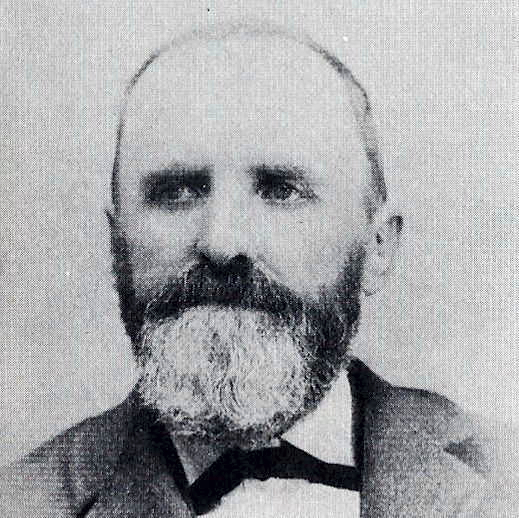 Photo: Rgreen1941 via Ancestry.com
Photo: Rgreen1941 via Ancestry.com
Edmund Taylor
Saturday, Jan. 19, 1850
I went with the young ladies and Babe up to Brother Bob’s. They then persuaded me to go with them to Uncle Howell’s, so as I had business at the (Brownsville) landing I concluded I would go. I went by Pa’s and got some documents that I wanted and fell in with them close by Mr. Thomas’s so Babe and I went on to the landing and left the girls in the care of Captain Smith. When we got there we heard the Harry Bluff coming down so we walked up to Tylio’s Landing and rode down on the Bluff to the Brownsville Landing. We then went to Uncle Howell’s and spent the night.Sunday, Feb. 3, 1850
I went home this morning from Pa’s to get some clothes to go to Memphis. I then went to Tabernacle and heard Mr. Sanderlin preach. This evening I went to the Brownsville Landing to get on a boat but I could not get it to take my cotton.Monday, Feb. 4, 1850
The Pitsor Miller was expected to be down in a day or two and I concluded before I would turn back I would remain in the evening. Weather fine.Tuesday, Feb. 5, 1850
I knocked about the landing today and did nothing of much importance but some more fellows came and we passed off the time very agreeably.Thursday, Feb. 7, 1850
We boys got some powder and an anvil and some matches this morning and busted an old tree open and fooled the whole country making them believe that the boat was coming and had them running down to see the boat. Tonight after dark the boat came up and laid at the landing all night.Friday, Feb. 8, 1950
This morning I rolled off for Memphis. We got down as far as the ridge field tonight about midnight the deck hands cried out fire and we had some scampering and running but it was soon extinguished.Saturday, Feb. 9, 1850
This day and night we traveled on very pleasantly but did not get quite to Memphis. The rain has bothered us a little as we could not stay much on deck.Sunday, Feb. 10, 1850
This morning by breakfast time we landed at Memphis. We got breakfast and we all pitched out over town to various points. I called on Colonel Jett and some of my other acquaintances and at twelve o’clock I attended the Presbyterian Church and heard a sermon delivered by the Rev. Mr. Grey. I then went to the Geyoso Hotel and got my dinner and in the evening I went to the Catholic Church and witnessed some of their peculiar ceremonies. This has been a very pretty day.Monday, Feb. 11, 1850
I sold cotton and attended to my other business today. I sold some cotton at 11 1/2 and some at 12 cents per pound. Tonight I went to the theatre.Tuesday, Feb 11, 1850
I knocked around town this morning and got my affairs straight and in the evening I went to a show of Canary birds and it surpassed anything I ever saw, they would do anything their master would tell them.Wednesday, Feb 13, 1850
We left Memphis sometime during last night and traveled a few miles when a log got in the wheel and broke it. Then we had to lay up until day. It snowed a little today and tonight it was so dark and snowing so fast that they could not see how to move the boat.Thursday, Feb 14, 1850
Tonight about midnight we struck at the Brownsville Landing and I was truly glad to get so near home once more. I left the landing this morning early and rode to Pa’s before I got anything to eat. I found Ma very sick. I took dinner at Pa’s and called at Uncle John’s and left him the money that I had sold his cotton for and then came home and found that brother Joe had attended to my business for me and that it had progressed finely.Taylor Kinsfolk Association at Tabernacle Church, Taylors of Tabernacle. Brownsville: Self published, 1957, 96-97.
Slightly edited for clarity
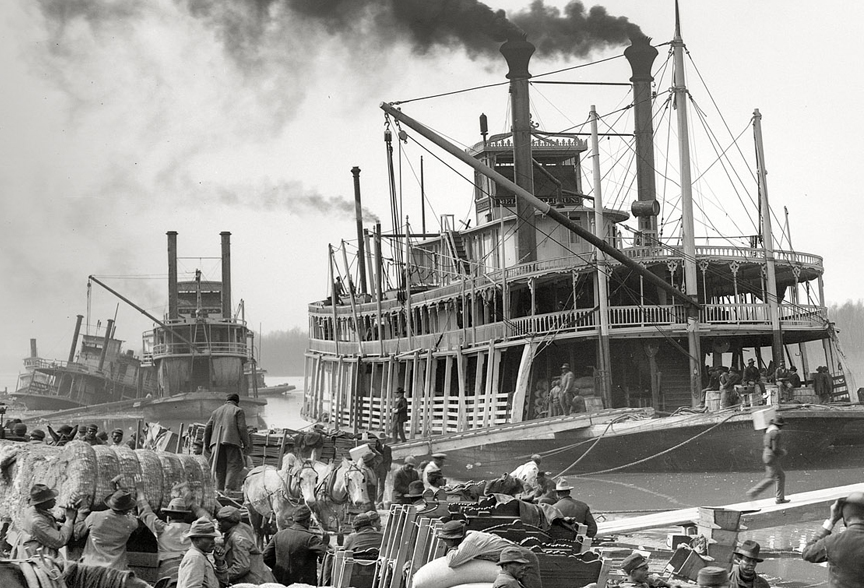 Photo: Shorpy.com
Photo: Shorpy.com
Steamboat landing in Vicksburg on the Mississippi around 1906.
The First Riverboat on the Hatchie
Another writer who really brings the Hatchie to life for me is Joseph S. Williams (1814-1878). Williams’ parents, Henry S. Williams (1785-1837) and Martha Macon Seawell (1790-1867), were among the earliest pioneers to settle in the region. In 1873, Williams wrote “Old Times in West Tennessee” in which he recorded his memories of a boyhood spent in “Big Hatchie Country.”
Williams recorded his version of the chaos that occurred with the arrival of the Red Rover, the first steamboat on the Hatchie River.
Old times in Haywood is memorable for many amusing incidents, anecdotes and “good things.” Among the most amusing, and yet remembered with a lively interest, occurred on the appearance of the first steamboat that came up the Big Hatchie. Her coming was heralded over the country several days in advance, and the day she would be at the Brownsville Landing named. All the men, women and children that could muster a horse or a go-cart (and many walked), turned out ‘to a man…’
As the boat neared the landing, the press and anxiety to see—to get the first sight—became intense…Not one in thirty of those who were there that day ever saw a steamboat, or knew anything about them save through scraps in the newspaper describing the horrible “blowing up” and destruction of life.
The dexterous pilot, judging well the place of landing as indicated by where the largest crowd was standing, with flying banners brought her to a blaze of glory amid shouts of welcome.
Just then the engineer raised his valves and let off steam, and the scene that ensued beggars all description. Men, women and children broke and ran for dear life. Some shrieking and screaming amid the deafening noise of the blowing-off sham which had reached its culminating point in the boilers…Everything looked as though the devil broke out of his harness. Many were so badly frightened that they did not stop running or look back until they were out of breath, and the frightened horses never stopped until they got home.
Williams, Joseph S. Old Times in West Tennessee. Memphis: W. G. Chenney Printer, 1873, 256.
Slightly edited for clarity
Up the Hatchie in a Flatboat

Joseph Williams wasn’t the only one to write about the appearance of the first steamboat to travel up the Hatchie. In 1867, Susan N. “Grandma” Smith published her autobiography, The Soldier’s Friend, in which she shared her version of the Red Rover’s arrival which was experienced from the river itself.
In February 1828, my oldest and youngest brothers, with my sister and myself, bade farewell to our beloved neighbors and home (Wilson County, Tennessee) and embarked in a flatboat which my brother had fitted out for the occasion, it being the usual mode of emigrating on water in those early days, We quietly glided down the proud Cumberland into the Ohio and from there to the father of waters, the Mississippi, to the mouth of the Hatchie; up its narrow crooked channel we continued our navigation by means of hooks and poles…a steamer had never been known to venture up its narrow confines until February 1828.
On a beautiful day of that month, while efforts were being made to extricate our little craft, which was fast upon a log, which seemed impossible to move, to our great joy and surprise, a beautiful little steamer bearing the appellation of Rover, came puffing and darting around a bend of the river. We were all delighted in seeing it, and we were proud to know we had the pleasure of seeing the first steamboat that ever followed the waters of the Hatchie…a banquet was prepared in honor of the captain and the ladies that were aboard; a grand reception was also given them by the citizen’s of Brownsville, which was then but a little village but is now quite a city.
Williams, Samuel Cole. Beginnings of West Tennessee. Johnson city: The Watauga Press, 1930, 121.
Slightly edited for clarity
Be sure to LIKE “Save the Hatchie” on Facebook for lots of great photos and info about the Hatchie River.
Protecting our Natural Resources
While the Hatchie River was not on my radar, others were well aware of its importance to the region and have been working to make sure it remains healthy,
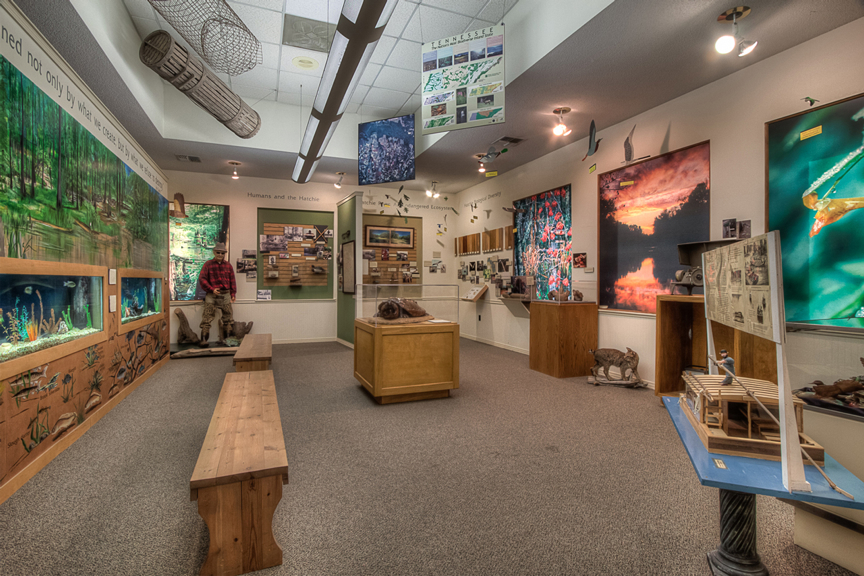 Photo: West Tennessee Delta Heritage Center
Photo: West Tennessee Delta Heritage Center
My friends at the West Tennessee Delta Heritage Center have been teaching visitors to the area about the Hatchie for years. Their Hatchie River Museum, located at the center, includes three fresh water aquariums filled with creatures who make the river their home.
 The Hatchie National Wildlife Refuge
The Hatchie National Wildlife Refuge
The Hatchie National Wildlife Refuge is located along 23 miles of the Hatchie River in Haywood County and covers 11,556 acres. Administered under the National Wildlife Refuge System, they protect and enhance the river’s ecosystem that supplies critical habitat needs for wintering waterfowl and other migratory birds, as well as a host of other fish and wildlife species. They also manage a visitor center in Stanton, Tennessee where you can also find out more about the river and their efforts to protect it.
More about the Hatchie River Wetland Mitigation Bank
In 2007, the Tennessee Wildlife Resources Foundation established the Hatchie River Wetland Mitigation Bank and 685 acres of land along the Big Muddy Creek was targeted for restoration. More than two miles of levees were removed, seven miles of ditches were filled and 224,000 native bottomland hardwood seedlings were planted. Today, the project is considered a big success.
Because the West Tennessee Wetlands provide such a unique habitat for a large number of plants and animals, The Nature Conservancy, partnering with the Tennessee River Basin Authority, has been focusing on conservation of the Hatchie River for more than two decades. Their goal is to “preserve the natural flow and function of West Tennessee’s streams and rivers through environmentally sensitive stream maintenance.”
Some may ask why it matters. According to the Conservancy:
Though modification of the landscape is widespread, the region supports a diversity of animals, including 130 species of fish, 50 species of mammals, 45 species of reptiles and amphibians and 37 species of freshwater mussels. Approximately 60 percent of bird species in the continental United States use this ecoregion, either as permanent habitat or as part of their migration route. In addition, the bottomland hardwood forests of this region are among the most productive bird-nesting areas in the United States. West Tennessee also supports the greatest variety of reptiles in the state.
 Sketch of the proposed Hatchie River Park and Nature Center
Sketch of the proposed Hatchie River Park and Nature Center
Bolivar, Tennessee has plans underway to take advantage of their proximity to the Hatchie to create a tourism and recreational destination which will bring much-needed revenue into their county. When completed, the Hatchie River Park and Nature Center will offer visitors outdoor water activities, boardwalks, restaurants and more.
Although none of this got me any closer to finding Brownsville Landing, it was fun to discover and share more about the history of the Hatchie and all the work being done by all these organizations to protect the river and wetlands. It’s an important part of being good stewards of the resources that we’ll pass down to future generations.
You can find out more about each of my specific family lines at HaywoodCountyLine.com or read more blogs posts on my blog page.

Obediah Dodson, a Baptist preacher, was on a steam boat coming from Estonallie going to Memphis, it was a gambling boat, he began singing “Where the Soul of Man Never Dies,” and preaching, all the card games stopped and the cards thrown overboard, they stopped the boat at Brownsville Landing and Obediah Baptized all of them in the Hatchie.
Love that story. I’ve been re-reading your books this weekend. I always enjoy them and appreciate the hard work that went into them.
Have you contacted my uncle, Lynn Shaw, about this question? I will give you his number if you need it.
Beth
Thanks Beth – I messaged you on Facebook to get his number. I appreciate it.
Brownsville Landing was where the late Jimmy Holbrook had a clubhouse. You can tell very easily by the sunken roadbed behind the Marbury house that leads to the Landing. It is also at a wide bend in the river where Mark Holbrook has a pontoon docked. I have seen a picture of a hand-pull ferry at that exact location. It is very evident due to the high bluff just downstream from the Landing.
Thanks Joe. Is this the area you’re referring to?
